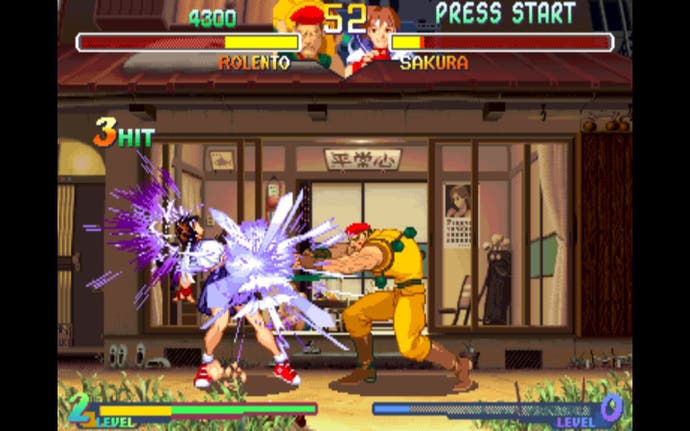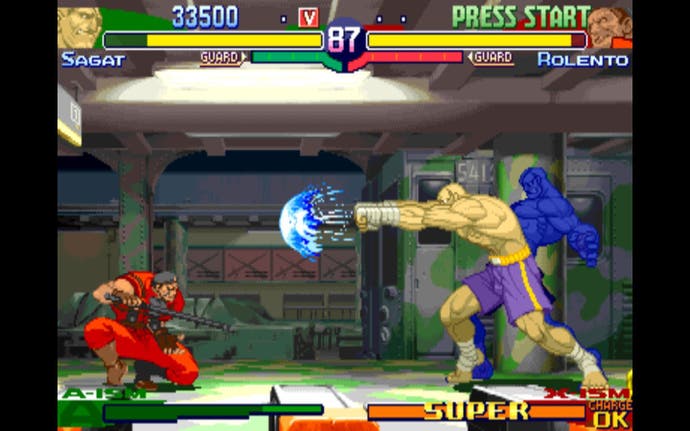Retrospective: Street Fighter
20 years of beat-'em-ups picked thoroughly apart.
Street Fighter Alpha
Series:
(1995) Street Fighter Alpha - Warriors' Dreams, (1996) Street Fighter Alpha 2, (1996) Street Fighter Zero 2 Alpha, (1998) Street Fighter Alpha 3
Alpha Mechanics:
- Air Blocking - it's like blocking, but in the air!
- Taunts - the proverbial middle finger
- Chain Combo - chaining standard attacks together
- Alpha Counter - break block stun to counter, requires one Super level
- Multiple Super - which is it?!?
- Level 1-3 Supers - supers now come in different flavours
- Break Fall - recover mid-air
- Tech Hit - throw back to negate damage
- Defensive Roll - after being floored, don't just stand up, roll away
- Custom Combo (Alpha 2) - DIY Super
- Guard Crush (Alpha 3) - you can't block forever
- Style Selection (Alpha 3) - which Ism will it be?
Having received positive feedback on the first Darkstalkers game, Capcom crafted the first Alpha in a similar anime style. As a prequel to Street Fighter II, Alpha brought back a lot of characters from Street Fighter I and II, including Chun-Li and Adon. Alpha also included Guy and Sodom from Final Fight, as well as new fighters Rose, Charlie (Nash in Japan) and Dan Hibiki. Dan is a secret joke character who resembles Robert Garcia from Art of Fighting - a retaliatory stab at SNK for Ryo Sazazaki's resemblance to Ryu and Ken, etc.

Considering Charlie played almost identically to Guile, some fans complained that, although Alpha was a complete overhaul to Street Fighter II, there was a lack of new blood. Alpha 2 helped to sweeten the deal with the return of Zangief, Dhalsim and Gen, Rolento from Final Fight and the first appearance of everybody's favourite school-girl Sakura. Evil Ryu and Shin Akuma also had their suped-up debus in Alpha 2. By the time Alpha 3 showed up the roster was starting to look cramped with many returning characters, plus Cody from Final Fight and Karin and R. Mika.
The first Alpha brought many new gameplay features to Street Fighter, including multiple Super moves per character, different levels of Super move power, the ability to taunt your opponent, air blocking, Chain Combos and Alpha Counters. Chain Combos allowed the player to cancel the animation of a standard attack with another standard attack effectively chaining moves together.
Alpha Counters were a guard-reversal system that allowed the player to interrupt their enemies' attack whilst blocking, at the expense of one level of the Super gauge. The change of dynamic between Super Turbo and Alpha was quite drastic. The use of Supers was much more important, as the gauge would fill to level one very quickly and the revamped combo system allowed for more impressive attack sequences. The ability to block in the air also lessened the risk of jumping in.
Mechanically, Alpha 2 wasn't a massive departure from the first Alpha, with minor tweaks being made to balance the old characters. The most significant change was the Custom Combo system, which replaced the old Chain Combos. With the Super gauge at level one or higher the player could initiate a Custom Combo by pressing two punches and a kick (or two kicks and a punch). The character would then move forwards with a blue shadow - similar to the Super animation. Depending on how high the Super gauge was stocked, this state would last for a few seconds with all the player's attacks being performed substantially quicker and with higher priority. The better Alpha players would often ditch the Supers in favour of their own crazy Custom Combos.

One of Alpha 3's greatest innovations was its three different Ism playstyles. After selecting a character each player had to choose between X-ism, A-ism or V-ism. X-ism (Simple) was reminiscent of Super Turbo - removing the ability to air block but slightly increasing standard damage output and giving the player access to a single powerful Super. Some characters in X-ism would also play differently - M. Bison, for example, would have his Alpha Psycho Shot replaced with his classic Psycho Crusher.
A-ism (Standard) was the most faithful mode to the previous Alpha games and allowed for air blocking, Alpha Counters and gave characters three different levels of Super - but crucially no Custom Combos. However, V-ism (Variable) was aimed at players who had mastered the Custom Combo in Alpha 2. Removing Supers completely, it came with its own V-ism gauge which could be activated by pressing a punch and kick of the same strength once half full. The blue shadow this time would double any attack made - so a Hadoken could result in two fireballs and be much harder to avoid.
In terms of the Alpha series' place in the Street Fighter legacy, it was really an everyman's fighter with accessible depth and recognisable characters. It was a very attractive fighter for the time and, certainly in the case for the first two games, was very much within the tail end of the fabled golden era of UK arcade gaming. Alpha 2 and 3 in particular still play very competently by today's 2D fighter standards. Street Fighter Alpha 3 Max for the PSP even has bonus characters including Yun from Street Fighter III and Ingrid from Capcom Fighting Jam - it's just a shame about the handheld's analogue stick.








